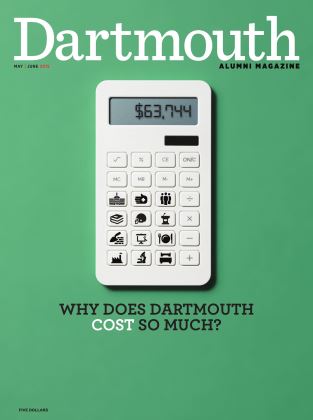FIT’s museum director is never out of fashion.
VALERIE STEELE ’78
RISHI SETHI ’11
JESSICA GLAGO ’08
TOM BARTLETT ’80
GARFIELD DEMARCO ’59
KYLE HENDRICKS ’12
IMAGINE THE MAGIC SCHOOL BUS’ Ms. Frizzle, dressed all in black save for a pair of printed cat-eye glasses, and you have an image of Steele. With an intellect and curiosity so unbridled that even her hair seems fraught with energy, Steele’s similarities to that fictional science teach- er extend far beyond the superficial. As an author, magazine editor and director of the museum at New York City’s Fash- ion Institute of Technology (FIT), Steele forgoes trips through outer space or to the ocean floor to examine a domain arguably even more enigmatic: the world of fashion.
“Our mission is to advance knowledge of fashion,” she says. “We’re trying to explain where fashion fits in culture and society and history, so that it’s more than just a question of weird or pretty dresses—so it’s got some kind of sig- nificance.” Called the
“Freud of Fashion” by The New York Times, Steele developed her interest in the field at Yale, where she did her doctoral research on modern European cultural and intellectual his- tory. She was inspired by texts on the Victorian corset to consider its cultural context—had it restricted women or liberated them?—and has worked since then to influence the way others think about clothing. Her efforts have resulted in exhibits ranging from “Dance & Fashion” to “Gothic: Dark Glamour” and more than 20 books.
In 2014 the Business of Fashion counted her among the 500 most influential people in the industry, naming her a “catalyst” alongside Steven Kolb, chief executive of the Council of Fashion Designers of America, and Helena Helmersson, chief sustainability officer of H&M. “I’m cata- lyzing ideas, getting people to think about what’s impor- tant about fashion,” says Steele. “I also try to put people together.” At FIT’S 2013 fashion symposium, for example, Steele invited a panel of lesbian, gay, bisexual and trans- gender designers and scholars to discuss the museum’s “Queer Fashion” exhibit, one of the first to explore gay style. With other, similar public programs scheduled throughout the year, the FIT museum’s commitment to teaching is a great source of pride for Steele. “Our educational mis- sion is really important,” she says. “It should be at [other costume museums] too, but sometimes it’s less so because of the need to do blockbusters. College and university mu- seums are often freer to do shows that might be in some sense controversial or cutting edge.”
Although some parts of her job are less than inspir- ing—“I do have a lot of fun putting on shows, but I also do a lot of normal administrative stuff with human re- sources and fundraising and endless meetings and so on,” she says—Steele clearly loves her work. She lights up discussing her favorite museum acquisitions (pieces by Alexander McQueen, Comme des Garçons and Rodarte) and says she is flooded with ideas for new exhibits all the time, and often starts to plan them years in advance. This year’s varied schedule includes shows on Yves Saint Laurent and Halston, global fashion capitals, and fairytale fashion.
So, what does Steele suggest for up-and-comers also interested in probing fashion? She says that, although there are fewer jobs for fashion journalists, there are more op- portunities in the visuals of fashion, such as fashion films, and in the business side of fashion. “It really depends what they see themselves doing,” she says—but within reason. A former FIT dean asked a graduate student what he was interested in. The student replied, “I want to be Valerie Steele.” “Actually,” the dean said, “that job’s taken.”
“I’m catalyzing ideas, getting people to think about what’s important about fashion,” says the museum director.
“For me, and younger generations of scholars, fashion has become a way to discuss social change,” says FIT’s chief curator.
 View Full Issue
View Full Issue
More From This Issue
MARLEY MARIUS ’17
-
 Article
ArticleHome Sweet Hogwarts?
NovembeR | decembeR By Marley Marius ’17 -
 Article
ArticleStudents and Profs Seek Change
JAnuAry | FebruAry By Marley Marius ’17 -
 Article
ArticleIn the Belly of a Beast
MARCH | APRIL By Marley Marius ’17 -
 FEATURE
FEATUREHorse Power
MAY | JUNE By MARLEY MARIUS ’17 -
 CAMPUS
CAMPUSHidden Necropolis
NOVEMBER | DECEMBER 2015 By Marley Marius ’17 -
 Features
FeaturesJoseph Campbell, class of 1925
JULY | AUGUST 2024 By Marley Marius ’17
Article
-
 Article
ArticleFORMER PRESIDENT NICHOLS CHOSEN HEAD OF M. I. T.
April 1921 -
 Article
ArticleHost to Historians
December 1947 -
 Article
ArticleAlumni Articles
June 1958 -
 Article
ArticleTuck School
MARCH 1971 By BOB KIMBALL T'48 -
 Article
ArticleMiami
APRIL 1970 By EDWARD R. HODGSON '42 -
 Article
ArticleTRADE, THE WORLD'S LIFEBLOOD.
DECEMBER 1969 By KAREN L. MENGE, JOHN A. MENGE







